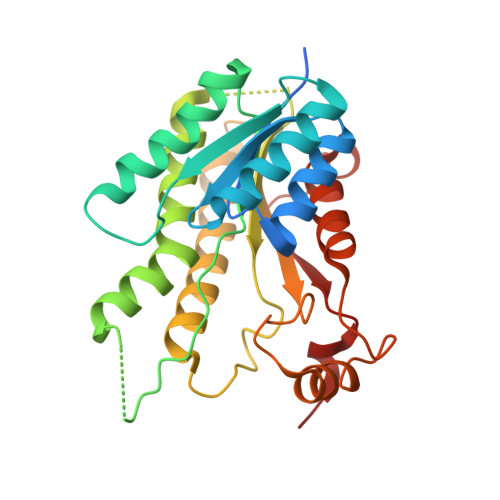Evidence of Pyrimethamine and Cycloguanil Analogues as Dual Inhibitors of Trypanosoma brucei Pteridine Reductase and Dihydrofolate Reductase.
Tassone, G., Landi, G., Linciano, P., Francesconi, V., Tonelli, M., Tagliazucchi, L., Costi, M.P., Mangani, S., Pozzi, C.(2021) Pharmaceuticals (Basel) 14
- PubMed: 34209148
- DOI: https://doi.org/10.3390/ph14070636
- Primary Citation of Related Structures:
7OPJ - PubMed Abstract:
Trypanosoma and Leishmania parasites are the etiological agents of various threatening neglected tropical diseases (NTDs), including human African trypanosomiasis (HAT), Chagas disease, and various types of leishmaniasis. Recently, meaningful progresses in the treatment of HAT, due to Trypanosoma brucei ( Tb ), have been achieved by the introduction of fexinidazole and the combination therapy eflornithine-nifurtimox. Nevertheless, due to drug resistance issues and the exitance of animal reservoirs, the development of new NTD treatments is still required. For this purpose, we explored the combined targeting of two key folate enzymes, dihydrofolate reductase (DHFR) and pteridine reductase 1 (PTR1). We formerly showed that the Tb DHFR inhibitor cycloguanil (CYC) also targets Tb PTR1, although with reduced affinity. Here, we explored a small library of CYC analogues to understand how their substitution pattern affects the inhibition of both Tb PTR1 and Tb DHFR. Some novel structural features responsible for an improved, but preferential, ability of CYC analogues to target Tb PTR1 were disclosed. Furthermore, we showed that the known drug pyrimethamine (PYR) effectively targets both enzymes, also unveiling its binding mode to Tb PTR1. The structural comparison between PYR and CYC binding modes to Tb PTR1 and Tb DHFR provided key insights for the future design of dual inhibitors for HAT therapy.
Organizational Affiliation:
Department of Biotechnology, Chemistry and Pharmacy, Department of Excellence 2018-2022, University of Siena, via Aldo Moro 2, 53100 Siena, Italy.


















